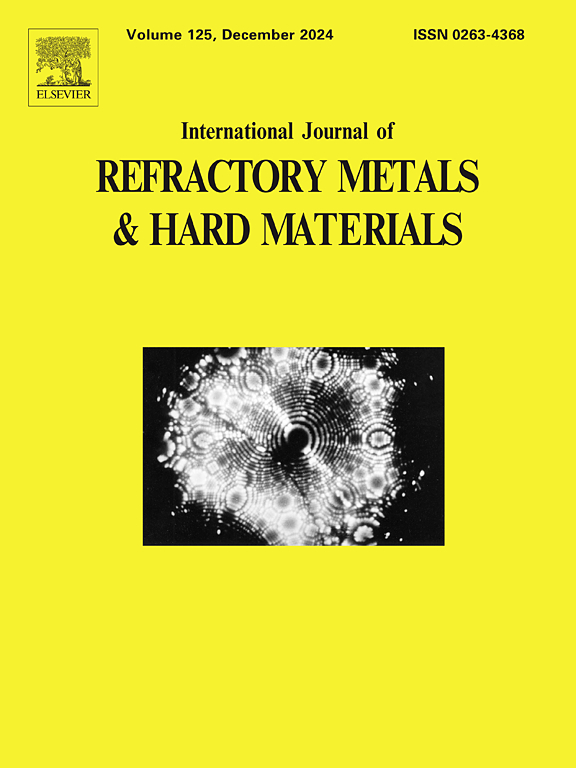An insight into the microstructure effects on removal mechanisms of cemented carbide WC-Co via molecular dynamics simulations
IF 4.2
2区 材料科学
Q2 MATERIALS SCIENCE, MULTIDISCIPLINARY
International Journal of Refractory Metals & Hard Materials
Pub Date : 2024-10-30
DOI:10.1016/j.ijrmhm.2024.106946
引用次数: 0
Abstract
The optical industry has raised the roughness requirements for molds made from cemented carbide to the sub-nanometer level. An in-depth understanding of the factors related to the mechanical removal of cemented carbide is imperative. In this study, molecular dynamic simulations are used to explore the behaviors of the microstructure and their effects on the removal mechanisms of cemented carbide. Two models of cemented carbide WC-Co and binderless WC are constructed, and a taper cutting simulation is designed with a diamond tool. Firstly, it is found that the WC grain amorphization is a temporary metastable phenomenon that is related to exterior stresses. Dislocations and stacking faults inside WC grains are primarily caused by the shear stress and grain rotation. Additionally, the size effect is interpreted through the transition between the elastic and plastic deformation. Then, the cutting force at the grain scale is found to be determined by the evolution and behaviors of microstructure. Finally, the impact of Co phases on stress accommodation and WC grain displacement are analyzed. The details revealed in this study can contribute to the understanding of the mechanical removal of cemented carbide and inspire more work on the improvement of machinability.
通过分子动力学模拟深入了解微观结构对硬质合金 WC-Co 清除机制的影响
光学行业已将硬质合金模具的粗糙度要求提高到亚纳米级。深入了解硬质合金机械去除的相关因素势在必行。本研究采用分子动力学模拟来探索微观结构的行为及其对硬质合金去除机制的影响。构建了硬质合金 WC-Co 和无粘结剂 WC 的两个模型,并设计了使用金刚石刀具的锥形切削模拟。首先,研究发现硬质合金晶粒的非晶化是一种与外部应力有关的暂时的易变现象。WC 晶粒内部的位错和堆积断层主要是由剪应力和晶粒旋转引起的。此外,尺寸效应是通过弹性变形和塑性变形之间的过渡来解释的。然后,发现晶粒尺度上的切削力是由微观结构的演变和行为决定的。最后,分析了 Co 相对应力容纳和 WC 晶粒位移的影响。本研究揭示的细节有助于人们理解硬质合金的机械去除,并启发人们在改善加工性能方面开展更多工作。
本文章由计算机程序翻译,如有差异,请以英文原文为准。
求助全文
约1分钟内获得全文
求助全文
来源期刊
CiteScore
7.00
自引率
13.90%
发文量
236
审稿时长
35 days
期刊介绍:
The International Journal of Refractory Metals and Hard Materials (IJRMHM) publishes original research articles concerned with all aspects of refractory metals and hard materials. Refractory metals are defined as metals with melting points higher than 1800 °C. These are tungsten, molybdenum, chromium, tantalum, niobium, hafnium, and rhenium, as well as many compounds and alloys based thereupon. Hard materials that are included in the scope of this journal are defined as materials with hardness values higher than 1000 kg/mm2, primarily intended for applications as manufacturing tools or wear resistant components in mechanical systems. Thus they encompass carbides, nitrides and borides of metals, and related compounds. A special focus of this journal is put on the family of hardmetals, which is also known as cemented tungsten carbide, and cermets which are based on titanium carbide and carbonitrides with or without a metal binder. Ceramics and superhard materials including diamond and cubic boron nitride may also be accepted provided the subject material is presented as hard materials as defined above.

 求助内容:
求助内容: 应助结果提醒方式:
应助结果提醒方式:


